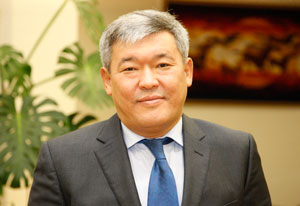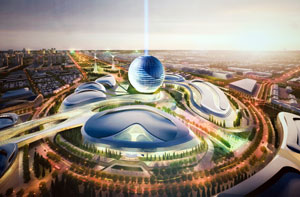 As host of EXPO 2017, Kazakhstan takes charge of an event with a long and influential history – which now, with a theme of future energy, may once again pioneer and promote game-changing technology. Over EXPO’s 160 year history, First Deputy Foreign Minister of Kazakhstan and Commissioner of EXPO 2017 Rapil Zhoshybayev told The Astana Times, the event has pushed the development of trade, science and technology, construction and, of course, tourism. EXPOs were the sites of the first demonstrations of the sewing machine, telephone and electric lighting systems, and facilitated the first international copyright agreements. Over time, they became forums for discussions of world problems.
As host of EXPO 2017, Kazakhstan takes charge of an event with a long and influential history – which now, with a theme of future energy, may once again pioneer and promote game-changing technology. Over EXPO’s 160 year history, First Deputy Foreign Minister of Kazakhstan and Commissioner of EXPO 2017 Rapil Zhoshybayev told The Astana Times, the event has pushed the development of trade, science and technology, construction and, of course, tourism. EXPOs were the sites of the first demonstrations of the sewing machine, telephone and electric lighting systems, and facilitated the first international copyright agreements. Over time, they became forums for discussions of world problems.
Zhoshybayev has high hopes for Astana’s EXPO. The record-setting Shanghai 2010 EXPO has set a new bar for subsequent events. “I think we will strive for this level in 2017 in Astana,” he said.
You represent the government of Kazakhstan and are responsible for attracting participating countries and organising the event according to the International Exhibitions Bureau’s standards. Can you tell about the progress and plans for the future?
Everyone is involved in the preparation and conduct of EXPO 2017. Much work is being done by state bodies and public organisations. The state commission headed by Prime Minister Serik Akhmetov is working hard, a national plan is under implementation, the government has identified responsible state agencies and organisations and built an effective scheme for their interaction. A huge amount of work to develop the registration dossier, plan construction and address many other issues is being done by the Astana EXPO 2017 national company established in January 2013. The Ministry of Environment is actively looking to embody the concept of EXPO 2017, Kazakhstan’s transition to a green economy and the implementation of the green bridge initiative.
As for me, as an official representative of Kazakhstan, I have to contribute to the implementation of our obligations in preparing and holding the international exhibition.
The organisation of the exhibition touches upon a very wide range of issues, from attracting international participants and visitors to the EXPO to creating the necessary infrastructure. In this regard, the commissioner’s authority also includes the promotion of trade, economic and investment cooperation with foreign participants and the promotion of programmes and projects to develop Kazakhstan’s tourism industry. … Guests expect to see the country they’re visiting, to learn the traditions and cultural heritage, to visit the natural parks, see historical sights and taste national dishes.
Taking into account that implementing EXPO 2017 is closely related to the development of tourism in our country, informative meetings have been held with the heads of state tourism structures and associations in Germany, the U.K., Austria, Italy, Latvia, China, South Korea, Hong Kong and Macau and other countries on the issue of attracting foreign visitors and tourists to Kazakhstan. … A working group under my chairmanship has also been organised to develop foreign participation in the EXPO … bringing together deputy heads of concerned government agencies and organisations.
Our working group is considering issues of branding, developing tourism, attracting domestic and foreign guests and organising their stays in Kazakhstan as part of our EXPO preparation.
With regard to the future, the most important part of our work will be attracting the maximum number of international participants. We will sign individual agreements with countries on their participation in the exhibition. The bulk of this work will begin in the summer of 2014, after the approval of the registration dossier and transfer of the BIE flag and logo to Astana.
A plan for visits to foreign countries to attract participants for EXPO 2017 is under preparation.
What architectural structures will be symbols of EXPO 2017?
As envisioned in the project of the architectural competition winner [American company Adrian Smith+Gordon Gill Architecture], most of the energy consumed by EXPO visitors will be generated from renewable sources. All the buildings will use solar and wind energy. Kazakhstan’s pavilion will be surrounded by international, thematic and corporate pavilions, creating an integrated group of buildings. In the exhibition area there will be an Art Centre designed specifically for the exhibition’s cultural and entertainment programme, an area for best practices that will showcase the best examples of alternative energy use, as well as a Congress Centre.
Our capital will not just get another sight to see and the accompanying architectural complex, but also a legacy of developing scientific potential, advanced technologies and creating an innovative environment. This project will serve as a catalyst for the development of new industries that will provide a unique experience and create jobs, while at the same time pioneering new principles of green construction that will contribute to the implementation of new standards in this field.
There will also be projects necessary for the development of the capital’s infrastructure, such as the new railway station, additional airport terminal, hotels, recreational houses and shopping centres. All of this will help us receive visitors in a dignified manner. And most importantly, we will create more comfortable living conditions for our citizens.
The benefit for the capital is obvious. Tell us in more detail about what Kazakhstan will gain as a whole, in addition to the obvious prestige the event brings?
Expert opinion on the matter is suffering somewhat from tunnel vision in its estimation of EXPO 2017 as the next public relations tool for the country. This point of view simplifies the real significance of such a universal event … . EXPO 2017 is, of course, another opportunity for Kazakhstan to demonstrate not only its unique history and culture but also to show its achievements, its own innovative strength. EXPO 2017 as a national project could give a powerful boost to further diversifying and modernising our economy. The tourist industry, the hotel industry and the service sector will get a big boost, including the development of small and medium-sized businesses and new jobs.
I would also like to note that the objects being built as part of the EXPO will work [toward] the positioning of Kazakhstan and our capital as a major international exhibition and information-presentation platform. As for getting a quick profit from the exhibition, it is a quite understandable and natural desire. However, the EXPO’s history is not replete with examples of making big profits on the spot. There are some exceptions, though, the most recent being EXPO 2010 in China, where organisers saw a profit of US$12 billion. Interestingly, it’s not only the host countries that benefit from EXPOs. The Netherlands saw a tenfold profit from their pavilion at EXPO 2000 in Hanover, Germany. Investing no more than US$47.3 million, the Dutch brought about US$473.9 million into their economy. The direct economic impact of the exhibition and its additional benefits should be kept in mind. For example, in Canada in 1967, the EXPO cost 283 million Canadian dollars (US$241 million), but the profit from the event was demonstrated in the country’s increased tourism income, which reached 480 million Canadian dollars (303 million euros) that year.
Undoubtedly, EXPO 2017 will give a new impetus to the development of the economy, science, technology and culture. This is a chance not to be missed. After all, the exhibition is a kind of technology transition to a new level of quality of life. For the host country, this is an effective way to involve all its accumulated potential: technical, creative and entrepreneurial.
Why was Future Energy chosen as the EXPO 2017 theme?
According to the International Energy Agency (IEA), in the next quarter century, mankind will face two global threats simultaneously: a shortage of energy resources and environmental disaster, so the topic is relevant. It should be noted that the rational use of energy resources in Kazakhstan is considered a strategic task. The Kazakhstan 2050 strategy sets a goal of using alternative energy for half the country’s energy consumption by 2050.
In his State of the Nation address in 2012, the president also stressed the need to develop green energy and actively introduce technologies that use sun and wind energy. It is important that the EXPO 2017 site address these issues at the international level. In other words, Kazakhstan is ready to implement a new energy policy to realise its considerable innovative potential.


